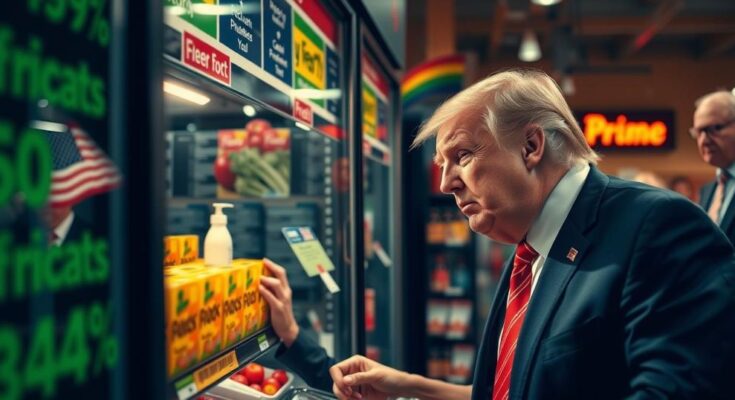Many Americans are concerned about rising food prices and are hopeful that President Trump can reduce grocery bills. Despite his campaign promises, economists warn that proposed tariffs and policies might actually raise prices. Voter sentiment ties Trump to the urgent need for economic change, but the complexities of food pricing suggest relief isn’t easy or immediate. Ultimately, significant shifts in policy and infrastructure are necessary for sustainable improvements in food affordability.
Amid rising food prices, many Americans look to President Trump for reprieve, hopeful he can reduce their grocery bills. Campaign promises included tackling inflation on essentials like bacon and cereal, as heard during his jubilant rallies where he assured voters, “We’ll get them down.” However, food inflation stemming from multifaceted crises — the pandemic, the Ukraine war, and avian flu — complicates this goal. Economists suggest that his proposals, such as tariffs on imports, may inadvertently escalate prices, spiking costs rather than alleviating them. As of now, food prices are up 28 percent from 2019, reflecting significant cost burdens for Americans. A survey reveals 70 percent of voters are deeply concerned about food costs; the weight of grocery bills bearing down. Unsurprisingly, voter sentiment reflected in AP VoteCast reveals a connection to Trump, as 60 percent of those acutely worried supported him, contrasting with Vice President Kamala Harris who appealed to the less concerned electorate. Trump’s strategy to bolster farmers includes imposing tariffs of up to 60 percent on Chinese goods, alongside a universal 10 to 20 percent tariff on other imported items. However, experts like David Ortega, an agricultural economist, warn that higher tariffs could inflate costs for imported necessities like fertilizer and packaging, ultimately pressuring food prices higher. Moreover, deporting undocumented workers, who comprise a significant portion of the agricultural labor force, could further strain production and escalate grocery costs. Concerns don’t end there; energy costs, a lesser concern in the grand scheme, were also targeted by Trump. His ambition to cut these costs by increasing domestic drilling could resonate with voters, yet energy contributes only a small fraction — roughly 4 cents of every dollar spent on food. Consequently, while energy and tariffs serve as focal points of his strategy, experts caution their limited impact and the complex interplay of factors elevating food prices. The narrative is layered; while voter sentiment encapsulates hope in Trump’s business acumen for cost reduction, the reality remains plastic. With the economy at the forefront of voters’ minds, the expectation of returning grocery prices to pre-COVID levels seems increasingly elusive. Experts emphasize that a president’s power to directly alter food prices is limited; lasting changes arise from systemic shifts and internal reforms in agriculture and market competition. As the nation contemplates the electoral decisions of today, the whispers of future economic tides loom large. Instead of chasing shadows of reduced prices, the dialogue should shift toward ensuring income levels align better with rising costs. After all, it is the balance between earnings and expenditures that shapes the true picture of economic health. Amidst this dance of hope and reality, the quest for a more sustainable future beckons beneath the surface of the grocery aisles.
In recent years, food price inflation has emerged as a pressing concern for many Americans, compounding the financial strain on households. This inflation, exacerbated by factors such as the COVID-19 pandemic, geopolitical conflicts, and supply chain disruptions, has prompted voters to seek accountability from political leaders. During the election campaign, President Trump vocalized a commitment to tackle soaring food prices, appealing to a public desperate for relief. However, the complexities surrounding food economics hint at potential hurdles in translating promises into tangible results, with experts cautioning against simplistic solutions like tariffs or quick economic fixes.
In summary, the expectation that President Trump can swiftly lower grocery prices clashes with economic realities shaped by multifaceted global challenges. While he appeals to a distressed electorate aching for relief, experts underscore that truly effective change requires systemic reforms rather than fleeting promises. The focus should evolve from the illusion of reduced prices to fostering economic stability and ensuring that wages keep pace with the cost of living. The journey forward demands collaboration and innovation, reshaping not just grocery bills but the broader economic landscape.
Original Source: www.pbs.org



